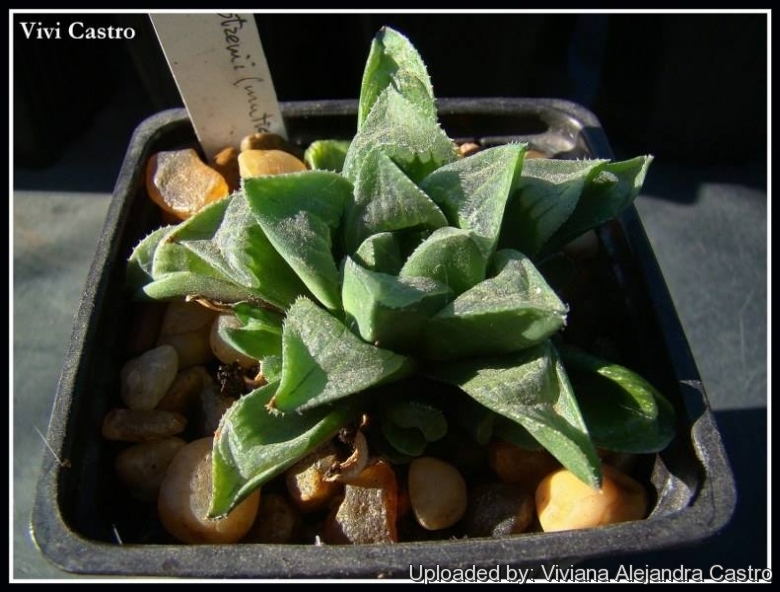Accepted Scientific Name: Haworthia mutica Haw.
Saxifrag. Enum. 2: 55 1821. (Revis. Pl. Succ. 55) Haw.

Haworthia otzenii Photo by: Viviana Alejandra Castro
Origin and Habitat: Haworthia otzeniiSN|16680]]SN|16799]] was apparently collected by Otzen from near Napier (Western Cape, South Africa), but plants subsequently collected there do not fit the original description. Napier is also the country of origin of Haworthia badiaSN|16799]]SN|16680]].
Synonyms:
See all synonyms of Haworthia mutica
back
Accepted name in llifle Database:Haworthia mutica Haw.Saxifrag. Enum. 2: 55 1821. (Revis. Pl. Succ. 55)Synonymy: 4
Accepted name in llifle Database:Haworthia mutica var. nigra M.B.BayerHaworthia Revisited 126 (1999)Synonymy: 2
back
Description: Haworthia otzenii is a medium-sized stemless species that consist of pale to dark green rosettes with parallel light markings on tips. The plant is suckering and blush bronze when grown in bright light.
Remarks: Haworthia otzeniiSN|16796]]SN|16799]] G.G. Smith is regarded by Bayer as a synonym of Haworthia muticaSN|16799]]SN|16796]] Haw. var. mutica, but even if the the place where this plant was first collected is known, there are no original specimens and plants subsequently collected there do not fit Smith's description, furthermore plants in cultivation under this name appear to be hybrids of Haworthia mirabils. So much confusion surrounds the name that some suggests that it should not be used.
Subspecies, varieties, forms and cultivars of plants belonging to the Haworthia mutica group
 Haworthia mutica Haw.: has compact flattened rosettes of retuse and prominently windowed leaves. Distribution: Western Cape.
Haworthia mutica Haw.: has compact flattened rosettes of retuse and prominently windowed leaves. Distribution: Western Cape. Haworthia otzenii G.G.Sm.: has green leaves with parallel light markings on tips, but plants in cultivation appear to be hybrids of Haworthia mirabils. Distribution: Napier, Western Cape.
Haworthia otzenii G.G.Sm.: has green leaves with parallel light markings on tips, but plants in cultivation appear to be hybrids of Haworthia mirabils. Distribution: Napier, Western Cape.
Bibliography: Major references and further lectures
1) Doreen Court “Succulent Flora of Southern Africa” CRC Press, 01/Jun/2000
2) Urs Eggli “Illustrated Handbook of Succulent Plants: Monocotyledons” Springer, 2001
3) Charles L. Scott “The genus Haworthia (Liliaceae): a taxonomic revision” Aloe Books, 1985
4) Stuart Max Walters “The European Garden Flora: Pteridophyta, Gymbospermae, Angiospermae-Monocotyledons” Cambridge University Press, 1984
5) M. B. Bayer “The new Haworthia handbook” National Botanic Gardens of South Africa, 1982
Cultivation and Propagation: Haworthia otzeniiSN|16799]]SN|16799]] grows best in bright but indirect, or moderate light or redden nicely in full sun. It grows without any major problems in cultivation and is an ideal small indoor plant. Outdoors it suit in rockeries, but avoid frost.
Soil: They are slow growing and prefer a porous, well-draining soil.
Moisture: They need regular water, but don't let the soil be constantly moist or soggy and while not wanting to be excessively wet, they will be equally unhappy if the soil is kept dry for long periods.
Hardiness: They do best in warm dry climates. Frost Tolerance: -1.C° (or less for short periods).
Propagation: They should be propagated by seeds or vegetatively by leave cuttings or division of larger clumps.










